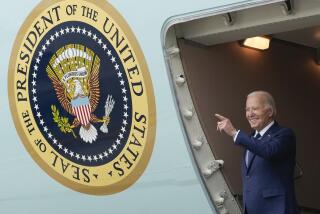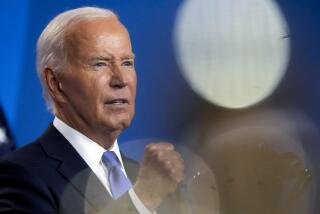A Ballot Like No Other
VATICAN CITY — Sometime in the next 20 days, the cardinals of the Roman Catholic Church will file silently into the Sistine Chapel and lock out the world. Praying for guidance only from the Holy Spirit, they will begin the task of electing a successor to Pope John Paul II.
Never do cardinals have more power to reshape the church than they do during an interregnum. This time, the church and its 1 billion believers await their choice with pent-up anxiety, deeply divided over John Paul’s 26 1/2 -year tenure.
Yet this College of Cardinals was reshaped profoundly by John Paul. All but three of the 117 electors were elevated by this pope, and the sheer weight of like-minded appointees is all but certain to result in a pontiff who also is conservative on questions of faith and morals.
It is not a college of carbon copies, however, and if history is any guide, the cardinals will elect a man who differs in other ways -- perhaps unexpected ways -- from his predecessor. Any number of contenders, each quite different from John Paul and from one another, could emerge as the next pope on the balcony in St. Peter’s Square.
“However loyal cardinals may be to the pope who created them,” the late church historian Peter Hebblethwaite wrote with the coming conclave in mind, “they are liberated by his death, free to make a fresh start. [They] do not necessarily vote for someone in the same mold.”
In any event, with all his crusading energy, charisma and anti-communism, John Paul would be hard to duplicate. And not all cardinals admire his more controversial qualities: his didactic approach to morality, his intolerance of dissent, his zeal to centralize power in the Vatican.
Even so, the cries of protest from his unruly flock, including Catholics alienated by his forceful rejection of birth control, homosexuality, remarriage after divorce, and ordination of women and married men, are unlikely to echo in this conclave. Church doctrine on such matters is settled for most cardinals -- or at least is not a burning issue.
Instead, the college will weigh leadership styles and personalities of would-be popes. The great divide in the church could boil down to a choice between a conservative with John Paul’s authoritarian bent and a conservative more willing to listen to other views or give marginal leeway to local bishops.
After the unprecedented reign of a Pole, the cardinals will debate whether to return the Vatican to a still-powerful Italian faction or to choose a pope from another country again, perhaps this time with a mind to the burgeoning ranks of Catholics in Asia, Africa and Latin America.
Issues of age, health, linguistic ability and clerical experience will also come into play.
When John Paul’s health began to decline in the mid-1990s, Vatican watchers began compiling speculative lists of papabili, or “pope-ables,” based on impressions the cardinals made on one another as potential leaders.
But taboos held: There was no candidate anointed by the incumbent, no overt politicking, no premature consensus on a successor. The contest begins in earnest now, in private talks that will fall under a secrecy oath once the conclave begins.
All this makes the outcome as unpredictable as a game of chance. “The change from one pope to another,” German historian Ferdinand Gregorovius wrote more than a century ago, “alters all conditions in Rome, as in a tombola, or lottery wheel.”
*
The Electors
In Catholic tradition, Christ made Peter the first pope but left no instructions on how to choose his successors. In the early centuries of the church, this task fell to the clergy and powerful families of Rome, who often waged war among themselves to put their man on the papal throne.
The College of Cardinals has been sole elector since 1179. Since 1271, it has voted in conclave, a term from the Latin for “with key” or “locked up,” in an effort to limit interference by secular monarchs and princes who sought to control the papacy well into the 19th century.
Cardinals now being summoned to Rome will be sequestered in the Vatican until they make their choice.
Since 1970, cardinals have been ineligible to vote after they turn 80, although they may otherwise take part in the conclave. The number of voting cardinals was expanded that year from 70 to a maximum of 120.
Until the middle of the 20th century, more than half the cardinals were Italians. Popes then began “internationalizing” the college to better reflect the distribution of the world’s Catholics. John Paul II was the first non-Italian pontiff in 456 years, but Europeans still have disproportionate power.
There are two kinds of cardinals: those in the Curia, or Vatican bureaucracy, and those who are bishops or archbishops in dioceses around the world. The curial cardinals, generally multilingual and skilled at ecclesiastical politics, are usually more influential in shaping the choices of candidates, especially in the pre-conclave campaigning.
Any baptized Catholic male may be elected pope. But for centuries the cardinals have chosen one of their own. With all voters and candidates locked in the Sistine Chapel, the campaign is impossible for outsiders to follow, and much remains a mystery.
“The problem with covering a conclave is we have no documentation on the debate inside or how it was conducted in the past,” said Marco Tosatti, Vatican correspondent for the Italian newspaper La Stampa. “Information leaks out, but it’s contradictory, not always reliable.”
*
The Balloting
According to the Apostolic Constitution, the conclave must begin 15 to 20 days after a pope’s death. Technicians sweep the chapel and the cardinals’ quarters for eavesdropping devices. Newspapers, radios, TVs, tape recorders, phones and cameras are barred. Windows are sealed and curtains shut to prevent signals to or from the outside.
Absolute silence is the rule during the voting by paper ballot. The cardinals sit at 12 long tables beneath Michelangelo’s frescoes “The Creation of the World” and “The Last Judgment.” They hold no more than two ballots each morning and two each afternoon, with a one-day recess between each round of seven ballots, if needed, until a winner emerges.
In initial voting, a two-thirds majority is required for election. After each half-day session, all ballots and tally sheets are burned, together with a chemical cartridge selected to send either black or white smoke via stovepipe through the chapel’s roof: white to announce to the world that a pope has been elected, black to report that balloting has been inconclusive.
Cramped living quarters at previous conclaves were thought to encourage decisiveness, and, in fact, each conclave since 1831 has ended in four days or less.
At this conclave, for the first time, cardinals will have comfortable Vatican apartments. As they were being built, in 1996, John Paul amended the rules to prevent a long deadlock: If no one achieves a two-thirds majority after four seven-ballot rounds of voting, which could extend to 12 days or more, a pope may then be elected between the top two contenders by a simple majority of half plus one. This change, some argue, works against the tradition of seeking consensus around moderate, pragmatic candidates. For example, backers of a divisive contender who gains just over half the votes but keeps falling short of two-thirds could simply hold out until the fifth round and elect their man.
“There is no incentive for them to compromise or move to another candidate,” says Father Thomas Reese, a Vatican specialist at Georgetown University. “In fact, the incentive is reversed.... This change increases the likelihood of a more radical and ideological candidate being elected.”
*
The Qualifications
Radical or moderate, a candidate can improve his chances by being a polyglot pastor old enough to retire from most other jobs. The surest way to make an impression at a gathering of cardinals from 52 countries is to speak fluent English, Spanish, Portuguese, French and Italian -- dominant languages of the Catholic world. This is especially true because no interpreters are allowed in the conclave, unless they also happen to be cardinals.
Past voting indicates that the cardinals will be reluctant to elect a Vatican bureaucrat with no experience as a bishop, although having both backgrounds is considered a plus.
The cardinals often look for a pope who balances out the negatives of his predecessor.
Those who felt John Paul’s reign was too long will not want to elect another relatively young pope; someone healthy enough to live about a decade, would suit them better. If they seek a compromise candidate for a shorter, transitional papacy, he could be even older or more fragile.
For those desiring a less forceful, more flexible pope who can reach out to alienated Catholics, the choices are less clear-cut. Most of the widely mentioned papabili sound diplomatic enough now; how each might behave as pope in the face of dissent is unpredictable.
With the Cold War over, the cardinals may also want a break from John Paul’s cold-warrior mind-set, and that would exclude another Eastern European. Being from the lone remaining superpower would handicap any American with papal ambitions.
Some of Italy’s 20 cardinals, still the largest single-nation bloc, speak privately of the need to end “the foreign experiment.” Others believe John Paul’s election in 1978 broke a geographical barrier and diminished nationality as a consideration.
“Anything becomes possible,” Italian Cardinal Achille Silvestrini once told an interviewer. “It could well be that a Latin American or an African could emerge” as the next pope.
*
(BEGIN TEXT OF INFOBOX)
Potential papal candidates
Here are nine cardinals who could figure prominently in the selection of the new pope, either as candidates or behind the scenes:
Francis Arinze
Age: 72
Head of Vatican office overseeing worship and the sacraments. Magnetic but humble Nigerian who won praise as a bridge builder to Muslims in his country.
--
Giovanni Battista Re
Age: 71
Prefect of Vatican department overseeing the appointment of bishops. An insider considered diligent and approachable.
--
Godfried Danneels
Age: 71
Archbishop of Brussels. Blunt and not charismatic, but admired by liberals as a man of consensus.
--
Claudio Hummes
Age: 70
Archbishop of Sao Paulo, Brazil. A conservative on church doctrine who has also defended the poor and landless of the nation with the most Catholics.
--
Claudio Hummes
Age: 70
Archbishop of Sao Paulo, Brazil. A conservative on church doctrine who has also defended the poor and landless of the nation with the most Catholics.
--
Joseph Ratzinger
Age: 77
Enforcer of church doctrine at the Vatican.
Likely to serve in a kingmaker role, but conservatives could seek to elect him as a caretaker pope.
--
Camillo Ruini
Age: 74
Vicar general of Rome. Brilliant but polemical and remote.
--
Christoph Schoenborn
Age: 60
Archbishop of Vienna. A respected theologian, well-connected at the Vatican but may be seen as too young.
--
Angelo Scola
Age: 63
Patriarch of Venice. From a city that has produced many popes. Would please the most conservative branches of the church but has promoted progressive causes such as interfaith dialogues.
--
Dionigi Tettamanzi
Age: 71
Archbishop of Milan. Conservative but affable. Often mentioned as a front-runner, but appearance of ambition could spoil his chances.
*
Sources: Times reporting.
More to Read
Sign up for Essential California
The most important California stories and recommendations in your inbox every morning.
You may occasionally receive promotional content from the Los Angeles Times.











